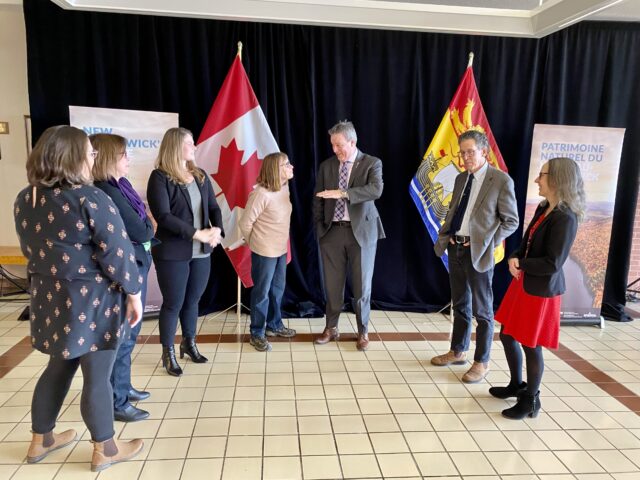Traditional territory of the Wabanaki Peoples/Fredericton—A coalition of four provincial environmental and conservation organizations — Canadian Parks and Wilderness Society-New Brunswick Chapter, Conservation Council of New Brunswick, Nature NB, and the Nature Trust of New Brunswick — issued the following joint statement in response to the government of New Brunswick’s Nature Legacy announcement today.
“We are encouraged to see the provincial government designate an additional 277,900 hectares of new protected areas to fulfill its commitment to protect 10 per cent of lands and waters in the province.
Today’s announcement is the largest one-time increase in protected areas in New Brunswick’s history and represents a significant leap for nature conservation in the province.
The unique natural spaces and wildlife we love in New Brunswick are threatened by development, intensive industrial uses and climate changes. In New Brunswick, over 88 species are listed under the provincial Species at Risk Act. The dual crises of climate change and biodiversity loss demand real action and solutions now. When we conserve and connect intact and functioning ecosystems, we help protect beloved rare, endangered, and at-risk plants and animals that rely on New Brunswick habitat for their survival.
The Nature Legacy initiative has been a long time in the making. Since 2018, our organizations have partnered on campaigns to engage the New Brunswick government in Canada’s ambitious goal to conserve 17 per cent of land and freshwater by 2020. The provincial government committed in 2019 to protect 10 per cent of New Brunswick as part of the nationwide effort. Since then, the federal government has set an even larger goal of 30 per cent protection by 2030.
We are deeply grateful for the thousands of New Brunswickers who answered our call by standing up and demanding better protection of cherished wetlands, rivers, forests, coasts, and islands. From the Miramichi and Nashwaak river watersheds to old forests and river corridors in the headwaters of the Restigouche, many of these new protected areas were nominated by the public and can continue to provide habitat for at-risk species, such as piping plovers, inner Bay of Fundy Atlantic salmons, wood turtles and monarch butterflies.
As world leaders currently gather in Montreal to find solutions for the growing crisis of nature loss at the 15th Conference of the Parties to the UN Convention on Biological Diversity (“NatureCOP”), today’s announcement is an example of taking concrete steps to address this crisis here at home.
There is still much work ahead if New Brunswick is to do its part to achieve the national and international target to protect 30 per cent by 2030. In particular, we must follow through on commitments to reconciliation through conservation. Wolastoqiyik, Mi’gmaq and Peskotomuhkati peoples have been the stewards and knowledge keepers of these territories since time immemorial. Land and water protection can only be more successful with Indigenous-supported and Indigenous-led conservation initiatives.
As we look to the future of conservation in the province, it is critical that we continue to hold our governments accountable for implementing the recent Climate Change Action Plan by:
- setting a more ambitious provincial target for protected areas beyond 10 per cent, which aligns with federal targets and places New Brunswick as a leader across provinces
- developing and implementing a new biodiversity strategy that will maintain biodiversity and aid in the recovery of threatened and at-risk species and their habitats
- developing tools that help to understand forest and wetland contribution to climate action and increase their protection as important carbon stocks
- co-developing with Indigenous Nations new ways to manage and steward protected areas in ways that support Indigenous values and communities.
QUOTES:
“These new protected areas are a gift for nature, and a gift to all the people in New Brunswick who are connected to nature. This is the biggest step N.B. has ever taken to live up to our responsibilities as a part of nature, and to bring us into a better balance with the nature we depend upon for our health and the resilience of our communities. There is more to do, and it needs to be done in a way that empowers Indigenous-led conservation,” says Roberta Clowater, Executive Director, Canadian Parks and Wilderness Society – NB Chapter.
“We celebrate today’s commitment to protect old forests and headwaters fundamental to the health and well-being of plants and animals. We are at the beginning of a journey that brings more balance between nature protection and human activity; a journey essential to protecting biodiversity and holding carbon for climate protection,” says Louise Comeau, Director of Climate Solutions, Conservation Council of New Brunswick.
“Today’s announcement is a significant step toward the protection of the wetlands, rivers, forests, coasts and islands we all love. We are thrilled to see new protected areas being established next to existing nature preserves, expanding important wildlife refuges and creating safe passageways for moose, bald eagles, wood turtles, warblers, and Canada lynx. Setting aside these special and sensitive ecosystems is a critical lifeline for species threatened and at risk in the face of climate change and habitat loss.” – Stephanie Merrill, Chief Executive Officer, Nature Trust of New Brunswick.
“New Brunswickers have time and time again, expressed their deep connection with nature and their desire to protect our natural heritage for future generations. Today’s announcement is a reflection of this Nature Legacy and an important step as we work together to halt nature loss and support the recovery of species at risk like the iconic piping plover and Monarch butterfly. There is still more work to do to move us forward and we look forward to supporting the province’s commitment to go beyond 10 per cent.” – Vanessa Roy-McDougall, Executive Director, Nature NB.
Recommended links:
- View the Nature Legacy interactive map, showing the new Nature Legacy sites, here.
- Read the government press release here.
To arrange an interview, contact:
Jon MacNeill, Communications Director | jon.macneill@conservationcouncil.ca | 506.238.3539

